Ball of the Foot Pain
Plantar Plate Injury & Plantar Plate Tear Treatment [Repair & More]
Do you have a plantar plate injury or plantar plate tear? We go over the BEST plantar plate tear treatment, shoes, taping, exercises & MORE!
Look:
- A plantar plate injury & plantar plate tear can be SERIOUS.
- We are foot doctors & we see this problem get better almost every day.
- The goal is to solve this problem without medication or surgery if at all possible.
So, let’s GO!
Table of Contents
Plantar Plate Tear Video:
We go over the best torn plantar plate and plantar plate tear treatments!
This also includes:
- Plantar plate tear taping.
- Plantar plate tear exercises.
- The best plantar plate tear shoes.
- Plantar plate tear surgery success rate.
- And plantar plate repair.
Plantar Plate Tear Pictures:
Below is some pictures of plantar plate tears.
- This infographic also shows some of the more common causes of ball of the foot pain.
- These can include fat pad atrophy, a Morton’s neuroma, metatarsalgia and hammer toe pain as well!
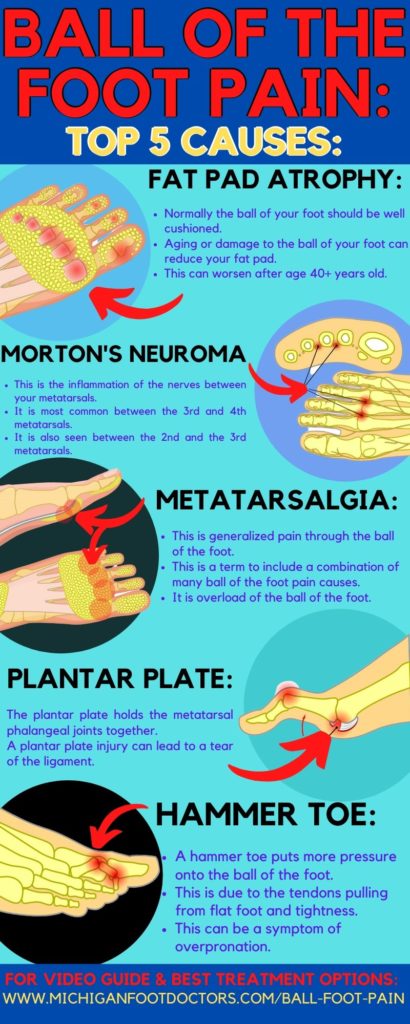
Ball of the Foot Pain Pictures & Photo Gallery:
Look:
- Metatarsalgia: which means generalized foot pain without a specific cause.
- Second toe capsulitis: this is the inflammation of the second toe joint capsule.
- Capsulitis is related to hammertoe formation, and can lead to a plantar plate tear. There is some overlap between these three disorders. As they get worse tearing and ligament damage can occur.
- Morton’s neuroma: this is the damage and inflammation to the nerves between and underneath the metatarsal joints.
- Fat pad atrophy of the ball of the foot: this is the loss of cushioning in the ball the foot.
- Plantar Plate Tear: A plantar plate tear is ripping of the ligaments holding the toe together.
So, click on the photo gallery to see the specific causes of your ball of the foot pain!
Click on the photo gallery to see the specific causes of your ball of the foot pain!
Plantar Plate Injury Overview:
A plantar plate injury occurs to the plantar plate ligament. This is a fibrocartilaginous structure found in the metatarsal phalangeal joint. It can most commonly occur in the second toe joint.
Plantar Plate Anatomy:
- A plantar plate tear or a plantar plate injury refers to these fibrocartilaginous ligaments. These plantar plate ligaments hold your metatarsal phalangeal joint together.
- The plantar plate is a very thick structure that stabilizes the attachment of your toe joints. It is at the bottom of the foot.
- The most common joint involved is the second metatarsal phalangeal joint. But the other toes can be affected as well.
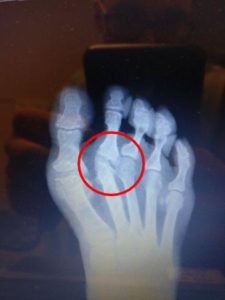
Plantar Plate Tear Symptoms:
The most common plantar plate tear symptoms include:
- Pain to the bottom of the second toe joint. Although it can affect the other toes, it is rarer.
- With a severe tear, the second toe can start to cross over the big toe joint.
- It is worse with increased activity.
- It is worse with being barefoot.
- It can hurt in the morning.
- A dull ache.
- The toe can feel like it is changing positions.
Plantar Plate Tear Grades:
Plantar plate tear grades are list 1-4 based on the degree of tearing:
Grade 0 is the least severe, with no tearing. This is considered a plantar plate injury where the fibers are stretched but not torn.
Grade 1 is less than 50% of the ligament being torn. This means that the toe is more mobile but not shifting or dislocated.
Grade 2 is more than 50% of the ligament being torn. This may result in more instability of the toe.
Grade 3 is a torn plantar plate ligament extending to over 50% of the ligament and the collateral ligaments. The collateral ligaments are on the sides of the second toe. This may result in the dislocation of the toe.
Grade 4 is a torn plantar plate ligament with hole formation in the ligament. This is a plantar plate rupture. This can result in dislocation of the second toe joint. As a result, this can cause the second toe to cross over the big toe joint.
For more on grades and variables: Link to Study.
How Does One Get a Torn Plantar Plate:
A torn plantar plate can occur as an injury or repeated overload stress.
- A torn plantar plate can be an acute injury or a chronic injury.
- An acute injury happens with one accident, whereas chronic injury slowly develops over time with repetitive use.
- Most plantar plate injuries are chronic over time.
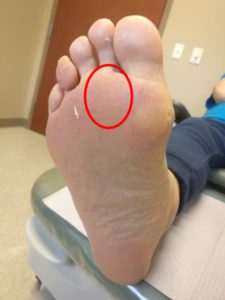
Acute injury:
An acute plantar plate rupture is less common. This type of plantar plate rupture could result from a trauma like a fall or motor vehicle accident.
The symptoms of an acute plantar plate tear are similar to something called turf toe injury. This is when your toe gets suddenly and excessively bent upward.
- This type of motion can strain the ligaments on the bottom of your metatarsal phalangeal joint.
- Some people can feel a pop or a tearing sensation.
- The toe can even dislocate and popped back into place with walking.
- In severe plantar plate tears, there could be bruising, and it can also cause the toe to be unstable.
- An untreated plantar plate tear can lead to a crossover toe or a dislocated toe.
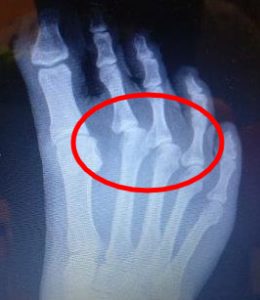
Chronic plantar plate tear:
This is much more slowly developing than one accident like the acute injury.
- Here there are microscopic tears that stretch out over time.
- A chronic injury can occur from trauma, where the initial plantar plate was undiagnosed.
- This is a challenging condition to heal and will take many months of conservative treatment and offloading.
- A plantar plate repair can also be performed surgically treated in some cases.
Untreated Plantar Plate Tears:
- A chronic plantar plate tear can still be treated with conservative therapy. If left untreated, it can lead to pain and toe dislocation.
- This can also be called a crossover toe.
- This article study states that an untreated plantar plate rupture can lead to mallet toes, claw toes, and hammertoes.
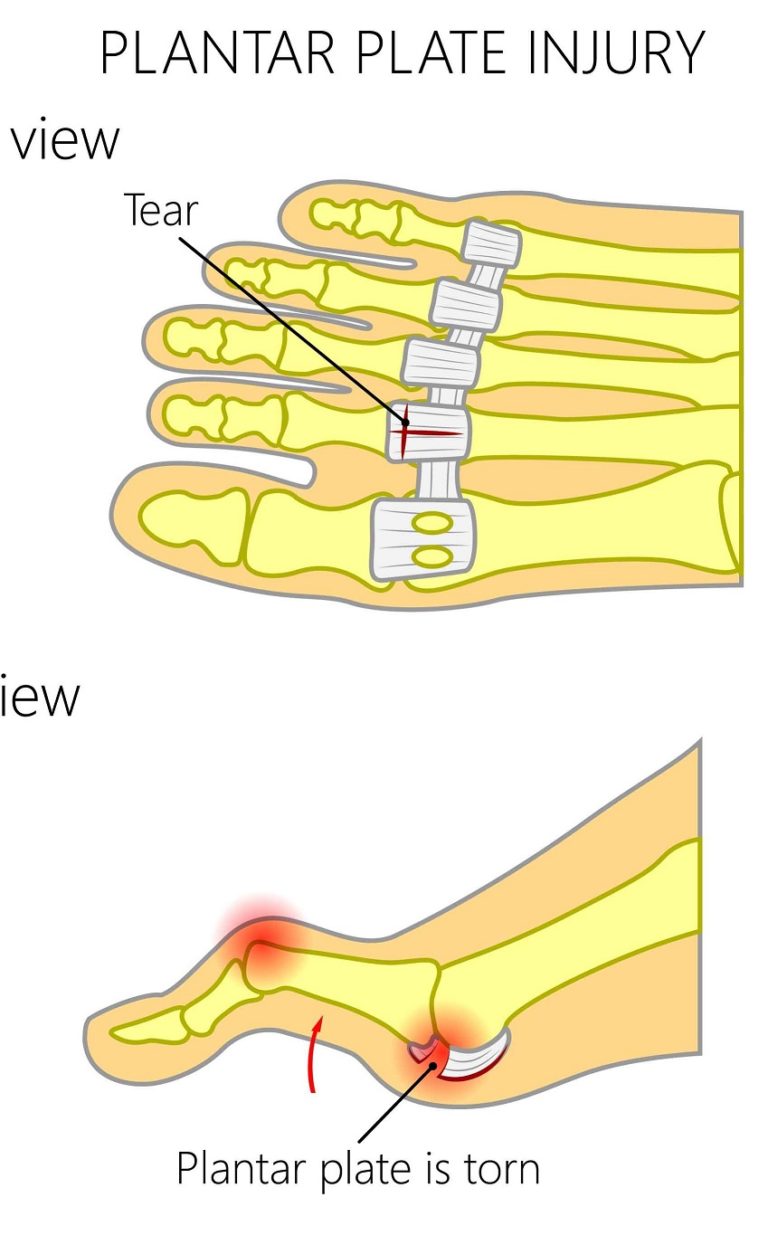
Plantar Plate Rupture Diagnosis:
- Most of the injuries we see are very subtle.
- This means that the toe is usually not obviously dislocated.
Podiatrist examination:
- If you are in Michigan, see us!
- Some studies show that the pain can radiate to the bottom of the foot, rather than just in the ball of the foot.
- This is because the plantar plate tear occurs close to where the ligament attaches the bone to the toe.
Lachman test (Plantar Plate Tear Test):
- The test to assess for a plantar plate tear is called a Lachman test.
- There is a test where you could grab the joint attempt to dislocated if the toe lifts superiorly.
- This does mean the ligament is torn. But in most cases, there is a mild to moderate tear, not gross dislocation.
Plantar Plate Tear X-rays:
- A plantar plate tear x-ray has its uses, but plantar plate ligaments can be visualized on x-ray imaging alone.
- This will tell us if there is a dislocation or a broken bone, which can be very common.
Plantar Plate Tear MRI:
- A plantar plate MRI may be necessary to assess for a plantar plate tear that is not improving.
- We personally prefer to start with ultrasound in our office.
- This can be very helpful with plantar plate injuries. There is minimal radiation, and there is low risk.
- The downside is an MRI is complicated and expensive in today’s insurance climate. It could also miss small or minor tears.
Plantar Plate Arthrogram:
- This is an invasive test where radiographic dyes are injected into the joint.
- This is not as commonly done anymore.
Plantar Plate Tear Treatment:
The following are our favorite plantar plate tear treatment options!
Plantar plate tear conservative treatment:
- Conservative treatment options for plantar plate injuries are very effective.
- As long as complete dislocation care has not occurred.
- Although this can happen in chronic injuries.
Walking Boot for Plantar Plate Tear:
- If there is evidence of a torn plantar plate, a walking boot for the plantar plate tear may be necessary.
- Before starting a walking boot for the plantar plate tear, we prefer to use an orthotic with a metatarsal pad.
- This plantar plate tear orthotic or plantar plate tear insole may take enough pressure off of the walking boot to make the air cast boot unnecessary.
If you need a walking boot for a plantar plate tear, see our best walking book recommendations!
Plantar Plate Repair Without Surgery:
A chronic plantar plate injury is treated similar to a hammertoe, where good orthotics and good shoe gear are utilized to keep pressure off chronic plantar plate injury.
These treatments include:
- Good supportive shoes.
- Good orthotics.
- Shoes with white toe box.
- Modify activities to decrease running and walking, focus more on biking and swimming.
- Cross-training and avoiding running.
- Stretching for your Achilles tendon and hamstring muscles.
- Podiatric care for calluses in the ball of your foot.
Plantar Plate Tear Taping:
A strong option is plantar plate tear taping.
The video above goes into detail regarding the plantar plate tear taping technique.
Taping and splinting usually need to be done for about 6 to 8 weeks, although in some cases, 3 to 4 months may be necessary for the patient.
If the plantar plate tear is not completely ruptured, there is still a possibility of healing the injury.
Plantar Plate Tear Taping:
This is one of our favorite plantar plate tear taping techniques:
- It is possible to do a figure 8 around the knuckle of the second toe.
- This tape would have to be reapplied before the use of athletic activity or running.
- This will prevent the toe from bending upward as you push off with the front of your foot.
- This is very effective for sporting events, but it is not practical to stay on because as you sweat eventually the tape will loosen.
- It is not a long-term solution.
- Watch the video at the beginning to find out how to do it!
Plantar Plate Tear Exercises:
In most cases, plantar plate tear exercises are not considered effective.
Think about a plantar plate tear as an actual injury that needs time to heal.
We recommend letting the plantar plate tear heal first and then worrying about exercises.
We find that using a walking boot for plantar plate tears is generally the best idea first. After about 4-6 weeks, plantar plate tear exercises make sense if it is feeling better.
Refer to the plantar plate injury video at the beginning of this page to review the best plantar plate tear exercises.
The Best Plantar Plate Tear Shoes:
- Getting a great supportive pair of plantar plate tear shoes will make sure that there is pressure removed from the ball of your foot.
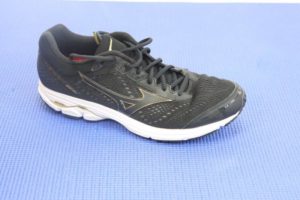
- This is especially important if you have a metatarsalgia and ball of the foot pain.
- Consider shoes combined with a good supportive orthotic for the best pain relief!
- The following link will show you what our favorites are.
The best men’s plantar plate shoes:
The below link shows our podiatrist recommended plantar plate shoes!
The best women’s plantar plate shoes:
The below link shows our podiatrist recommended plantar plate shoes!
The Best Plantar Plate Tear Orthotics:
In our opinion plantar plate tear orthotics can be one of the best ways to treat a plantar plate injury.
The key components to a plantar plate tear orthotics include a strong metatarsal pad, a deep heel cup and a reasonably aggressive arch.
Plantar Plate Tear Surgery:
- Plantar plate tear surgery is sometimes necessary for a nonhealing plantar plate tear.
- Can a plantar plate tear heal itself? The answer is most likely yes if the pressure is relieved and the tear is not fully torn.
- A grade 3 to 4 plantar plate tear is fully torn and will have difficulty healing without plantar plate tear surgery.
- On the other hand, if there is a gap between the ends of the plantar plate ligament, it may not reattach itself and heal.
- Research shows that this can be a very successful surgery in most cases with a high satisfaction rate.
- The goal behind plantar plate tear surgery is to reapproximate the ends of the plantar plate structure and to stabilize it in place with a pin or a cast until it can heal.
- The success rate behind plantar plate surgery can be very high in the right patient conditions.
Plantar plate repair:
- Plantar plate repair surgery consists of re-attaching the torn ends of the tear. A simple tear can be re-attached by way of “primary repair.”
- A complicated tear would be a grade 4 if there is a metatarsal phalangeal joint dislocation and the plantar plate are shredded.
- This would require more complicated re-approximation techniques that would require possible stabilization with a pin.
- Occasionally a bone anchor may be necessary to perform this type of plantar plate repair.
Plantar plate tear surgery success rate:
- Plantar plate tear surgery success rate can be very high in the right patient.
- If the patient has no other significant health problems, and if they can keep pressure off of the foot site in the plantar plate tear surgery success rate can do very well.
- Research shows that this can be a very successful surgery in most cases with a high satisfaction rate.
Can a plantar plate tear heal itself?
- It can be difficult for a plantar plate tear to heal itself if there is a high-grade tear such as a grade 3 or a grade 4.
- This generally means that there is displacement and dislocation of the toe.
- If there is dislocation and displacement of the toe, then this means that the ends are too far apart to heal themselves.
- In a partial tear such as a grade 0-2, the plantar plate tear can heal itself if the toe is protected.
- We recommend offloading with a walking boot for plantar plate tears.
Frequently Asked Questions:
Can a plantar plate tear heal on its own?
- Patients sometimes ask, “Can a plantar plate tear heal on its own?”
- Research shows that a grade 0 through 2 plantar plate tear or plantar plate rupture can usually heal independently.
- The trick is to follow with your podiatrist and make sure that there is enough pressure being taken off of the plantar plate tear.
- As the plantar plate tear progresses to a grade 3 or 4, the toe becomes dislocated. If the ligament is shredded and the ends are not aligned end to end, this plantar plate rupture will have a hard time healing.
How to fix a plantar plate tear?
- The best way to fix a plantar plate tear is to follow with your podiatrist. If you are in Michigan, come see us!
- As we mentioned earlier, a grade 0 through 2 can likely heal without plantar plate repair surgery.
- A grade 3 through 4 may require plantar plate surgery. The less complex the rupture, the higher the success rate of plantar plate surgery.
Can a plantar plate tear heal without surgery?
- Another way of asking this question is, can a plantar plate tear heal without surgery?
- The answer is a grades 0 through 2 can heal without surgery.
- Whereas a plantar plate tear grade 3 through 4 may require plantar plate surgery.
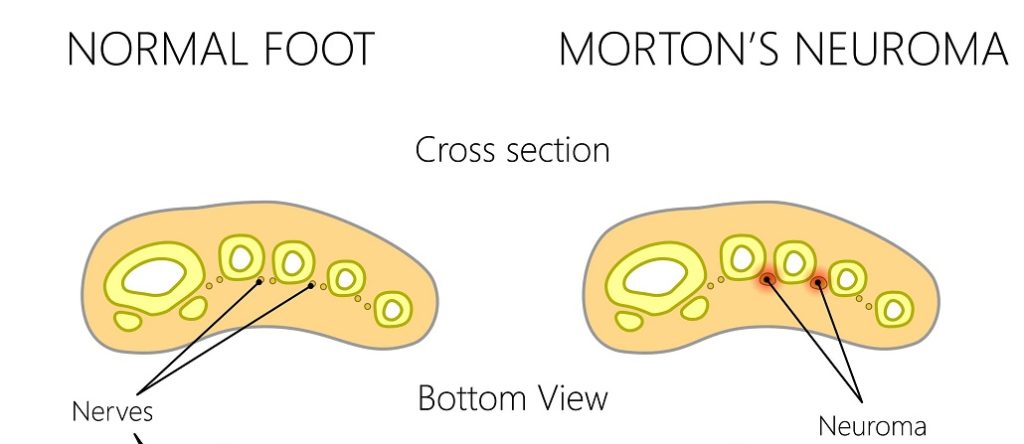
Plantar plate tear vs neuroma?
- How can you tell a plantar plate tear versus a neuroma?
- A plantar plate tear is usually below the metatarsal phalangeal joints.
- Whereas Morton’s neuroma is usually between the metatarsals.
- An experienced podiatrist can determine this thorough evaluation.
- In some cases, an x-ray, an ultrasound, or MRI may be needed.
- Sometimes in the very severe case, will have a lot of pain throughout the entire ball of the foot, and it will not be very easy to tell the difference between a plantar plate tear versus a neuroma.
Ball of the Foot Pain

